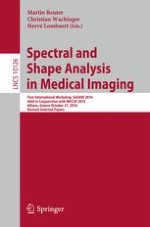2016 | Buch
Spectral and Shape Analysis in Medical Imaging
First International Workshop, SeSAMI 2016, Held in Conjunction with MICCAI 2016, Athens, Greece, October 21, 2016, Revised Selected Papers
herausgegeben von: Martin Reuter, Christian Wachinger, Hervé Lombaert
Verlag: Springer International Publishing
Buchreihe : Lecture Notes in Computer Science
